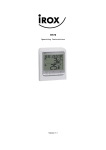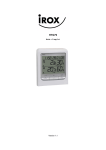Download Irox COMFO-X weather station
Transcript
Healthy living with the home climate hygrometer COMFO-X
The home climate hygrometer displays the ideal climate and indoor temperature, which is also dependent on the
season, in an easy to understand way. The coloured sections enable a fast and accurate reading to help maintain a
healthy and appropriate indoor climate.
The COMFO-X provides a major benefit during the heating period simply because you can monitor the ideal climate in
each room which is particularly important for preventing mould growth (see below step 1-3). As necessary you can then
either heat more and/or ventilate more to make the necessary improvements to the home climate.
1. By the thermometer at the bottom of the unit you can read the room temperature and find the colour that
corresponds with this temperature:
Dark blue low heating 16-18°C
Medium blue normal heating 18-22°C
Light blue high heating 22-24°C
2. On the blue display above determine the valid scale, with following differentiation:
Winter for temperatures under +5°C
3.
Autumn/Spring for temperatures of 5-15°C
On the scale for the outdoor weather you can now, by colour, determine
the ideal indoor moisture for the room temperature.
Example: For a room temperature of 20°C in winter the relative humidity should not exceed 40-50%, if this is the case
you can lower humidity by force ventilating the room for 5 minutes.
Information about the COMFO-X
The measuring accuracy is +/- 3% relative humidity in the range of 25 to 100% relative humidity. The measuring
element of the hygrometer is a specially pre-treated synthetic fibre which, as opposed to human hair, guarantees high
measuring accuracy even without maintenance.
Only units with real hair measuring elements need be moistened once a month and readjusted as necessary because
otherwise their measuring accuracy decreases. For COMFO-X though this is only recommended once a year. An
annual maintenance should be conducted after a longer time frame with low humidity, for example in spring after a cold
winter.
To do so, completely wrap the unit in a warm and moist cloth for about 30 minutes. The cloth should be moist but not
dripping wet! No hot water or steam should influence the hygrometer, otherwise the measuring accuracy can no longer
be guaranteed.
An inaccuracy in the moisture display can be corrected as follows:
- Compare the measuring value after unpacking, or 1 day after maintenance, with a reference instrument, i.e. a digital
thermo/hygrometer from Irox (www.irox.com).
- If you notice deviations, the display of the COMFO-X hygrometer can be corrected with a zero-point correction. The
correction screw is located in one of the openings on the side of the housing.
- With a screwdriver that fits turn the correction screw until the value on the display corresponds with the reference
instrument.
Placement of the measuring unit
The hygrometer must be placed in the right location to ensure reliable measurements. Choose a location on an interior
wall, at a medium height of 1-2 meters above the ground. Avoid cooler outer walls, window areas and close proximity to
radiators or direct sunlight.
As an alternative to wall mounting your device can also be set-up on the wooden stand. On the stand it is ideally
accessible for the room air and therefore reacts faster. Place the COMFO-X into the stand, slightly tilt forwards, and
then press slightly to the back. Make sure that it sits tightly in the stand and is secure.
www.irox.com © 2010 Irox Development Technology
Tips for ideal humidity in the home
Health risk – moisture in the home
Medical studies over the past years have confirmed that a high level of relative humidity in homes promotes more than
60% asthma and allergies.
Ideal is an indoor humidity of 40-50%.
A low indoor humidity of 30-40% is basically harmless. During harsh winters homes with a good air exchange even
have a relative humidity of less than 30% without this having a negative health effect. Some persons experience this
value as too dry. In such situations we recommend checking the Internet or consulting with experts.
--> How much moisture is necessary in the home during the heating period from October to April is determined
by the persons living there themselves.
About ten litres of water vapour accumulates in a 3-4 person household per day; showering, washing dishes/clothes,
cooking, exhaling and much more. Nowadays window seals are very tight, to conserve energy and for noise protection,
which means that this moisture must be ventilated to the outdoors several times a day.
--> The type of heating and ventilating is determined by the average relative humidity of the air in a home
during winter.
Because cold air always has less absolute moisture than the air in our rooms it is easy to exchange indoor moisture for
dry fresh air just by ventilating the room (short force ventilation periods according to the timing information on the
COMFO-X)
5 minutes
10-15 minutes
Every home (without a ventilation system) requires, depending on how many persons live there and the moisture
released an exchange of air several times a day. COMFO-X shows you exactly when it is time to ventilate!
How to achieve the right home humidity
The necessity to limit home humidity to prevent high values in normal living areas (not cellar!) exists for the most part
during the heating period, beginning with the heating period in fall. It is recommended to maintain a constant
temperature of approx. 20°C throughout the home. The range 18-22°C is marked in medium blue on the
thermometer.
In winter
When outdoor temperatures drop below +5°C indoor moisture of about 40-50% relative humidity is easily achieved by
sufficiently ventilating and maintaining the indoor temperature at approx. 20°C. This range is marked in medium blue on
your hygrometer.
If relative humidity rises over 50% the rooms should be ventilated.
During frost periods indoor humidity of less than 40% relative humidity is completely normal. Particularly in old houses,
with little heat insulation, it is important to maintain 40-50% relative humidity (at an indoor temperature of approx. 20°C)
as the upper limit, if this limit is not maintained there is the risk of mould growth.
What is important in summer?
With the exception of the cellar every room can be ventilated as you please. The COMFO-X knows no limitations for
ventilating during summer; humidity is always as high as the outdoor climate. This does not cause any damage
because the walls are sufficiently warm (except in the cellar).
In autumn and spring
When outdoor temperatures are milder for example 5-15°C a higher humidity of 50-60% relative humidity is possible.
For an indoor temperature of approx. 20°C this is marked in medium blue on the hygrometer.
Please note:
Warmer rooms are dryer (light blue) and
colder rooms have more moisture (dark blue).
We therefore strongly recommend not letting the temperature drop below 16°C in any room.
Healthy home climate by proper ventilation
At the latest when the windows are constantly clouded with condense water or mould begins to grow on the walls habits
should be checked and perhaps thought over.
The answers to following questions might be quite helpful for you:
How often should I ventilate?
Your home climate hygrometer can always give you the answer to this question. Whenever the hygrometer display
exceeds the blue range specified for the room temperature it is time to ventilate.
How long should I ventilate?
The hygrometer can answer this too: In winter, when temperatures are cold, under approx. +5°C, a maximum of 5
minutes is sufficient.
If it is milder outdoors (5-15°C), about 10-15 minutes are necessary.
How should I ventilate?
Effective air exchange is only achieved by opening the window or glass door of a room real wide ("force ventilation").
There is no need to cause a draught. Simply tilting a window, for ventilation, is absolutely insufficient and a waste of
energy.
What should I do if I am out of house during the day?
It is absolutely adequate if you ventilate when you are at home. This should be done at least once in the morning before
leaving the house, once when you return to the house and once in the evening before going to bed. It is just as
important that you do not turn the heating all the way down during the day (minimum 16-18°).
Should I ventilate when it is foggy or raining?
This is also very sensible. Even very cold, wet air always has less moisture than normal indoor air. Besides that you
also need fresh air when the weather is damp.
How should I ventilate the cellar?
Cellar rooms are at risk in summer because the outside air contains a lot of moisture then which condenses on cold
surfaces. Cellar flats should therefore, if possible, not be ventilated when outdoor temperatures are over 15°C or a
dehumidifier should be used.
Is it possible to dry clothing in the home?
Perfect for this purpose is a drying room that can be continuously (except in summer or during frost periods) ventilated.
Clothes should only be dried in the home if the room is closed off and very well heated. During the drying the room
should be ventilated very often. COMFO-X is the ideal aid for this too.










